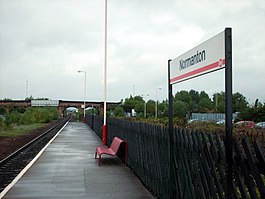Normanton railway station
| Normanton |
|
|---|---|

Platform 1
|
|
| Location | |
| Place | Normanton |
| Local authority | City of Wakefield |
| Coordinates | 53°42′02″N 1°25′25″W / 53.700490°N 1.423520°WCoordinates: 53°42′02″N 1°25′25″W / 53.700490°N 1.423520°W |
| Grid reference | SE381228 |
| Operations | |
| Station code | NOR |
| Managed by | Northern |
| Number of platforms | 2 |
| DfT category | F1 |
| Live arrivals/departures, station information and onward connections from National Rail Enquiries |
|
| Annual rail passenger usage* | |
| 2011/12 |
|
| 2012/13 |
|
| 2013/14 |
|
| 2014/15 |
|
| 2015/16 |
|
| Passenger Transport Executive | |
| PTE | West Yorkshire Metro |
| Zone | 3 |
| History | |
| Original company | North Midland Railway |
| Pre-grouping | Midland Railway |
| Post-grouping | London, Midland and Scottish Railway |
| 30 June 1840 | Station opened |
| National Rail – UK railway stations | |
| * Annual estimated passenger usage based on sales of tickets in stated financial year(s) which end or originate at Normanton from Office of Rail and Road statistics. Methodology may vary year on year. | |
|
|
|
Normanton railway station serves the town of Normanton in West Yorkshire, England. It lies 11 miles (18 km) south-east of Leeds railway station on the Hallam Line, which is operated by Northern.
The original station was opened by the North Midland Railway (NMR) on 30 June 1840 (this was one day before nearby Castleford Railway Station which opened on 1 July 1840) on their main line towards Leeds, creating an interchange station between the North Midland Railway (NMR), the York and North Midland Railway (Y&NMR) and the Manchester and Leeds Railway (M&LR) - establishing a three company junction.
It became the focus of several railway lines in the mid-19th century. Construction began in 1837 under the supervision of George Stephenson for the North Midland. This was soon followed by an addition from the York and Midland Railway and then by the Manchester and Leeds line which all joined at Normanton thereby giving the town access to much of the country. The NMR, already open between Derby and Rotherham (Masborough), was opened between Rotherham and Leeds (Hunslet Lane) on 1 July 1840, as was the Y&NMR between Normanton (on the NMR) and Burton Salmon (the line between Burton Salmon and York already being open). The M&LR route between Normanton and Hebden Bridge followed, opening on 5 October 1840, and on 1 March 1841, the final section of the M&LR route to Manchester was opened. The Leeds and Manchester lines crossed a 51 miles (82 km) stretch across the Pennines and at the time boasted the world's longest railway station platform at Normanton – a quarter of a mile (400m) long.
In Victorian times Normanton station was one of the most important stations in northern England and can boast that Queen Victoria stopped over in The Station Hotel. The town also served as an important part of the transport infrastructure for national and local industries including coal and bricks, although most of this was lost during the 1950s and 1960s with the last remaining operational brickworks eventually closing in the mid-nineties. There were three brickworks in town and were all built within the small area known as Newland, taking advantage of the abundance of clay from the area. A fourth works was founded in the 1890s by a man named Thomas Kirk from Nottingham who had heard rumours that Normanton was rapidly turning into an important junction on the railways. Both Kirk and his sons used their life savings and formed the Normanton Brick Company at nearby Altofts which is still in operation today.
...
Wikipedia
